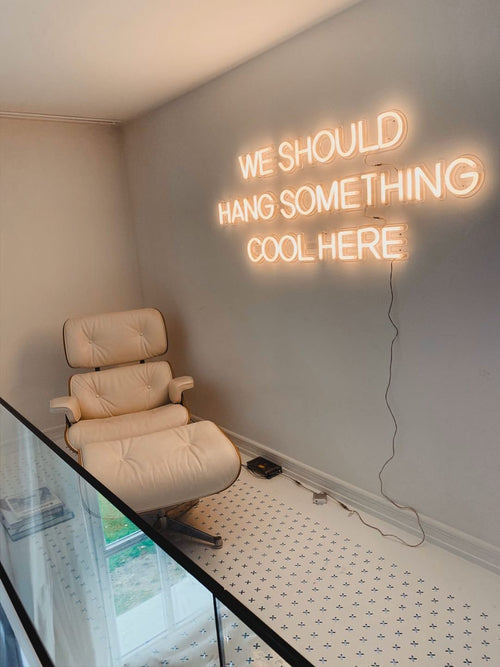Custom neon signs have been a symbol of energy, vibrancy, and style for decades. Whether it’s a trendy bar, a cozy café, or a personal living space, a custom neon sign can instantly transform any environment. The appeal of neon signs lies not only in their nostalgic charm but also in their ability to create a mood, convey a message, and add a touch of artistry to any space. Crafting a custom neon sign is a fun and creative process, and it can serve as a fantastic way to express your personality, brand identity, or aesthetic preferences.
In this guide, we will explore the various aspects of creating a custom neon sign, from understanding its history and the technology behind it, to choosing the right materials, colors, and fonts. By the end of this article, you’ll be equipped with the knowledge to design and order a neon sign that perfectly suits your needs, whether it's for business, personal use, or simply as a striking decorative piece.
The History and Appeal of Neon Signs
Before we dive into the creation process, let’s take a step back and understand why neon signs have become such an iconic part of visual culture.
Custom neon sign gas was discovered in 1898 by British chemists William Ramsay and Morris Travers. However, it wasn't until the 1920s that the first neon signs, which used this gas to produce a bright, colorful glow, were created. The earliest neon signs were used primarily in advertising, offering businesses a unique way to catch the eye of passersby in a vibrant and eye-catching manner.
The iconic image of neon lights was cemented during the 20th century, especially in places like Times Square in New York City, the Las Vegas Strip, and the bustling streets of Tokyo. Over time, neon signs began to move beyond advertising and into the realm of art, design, and personal expression.
Neon signs are unique in their ability to stand out at night, casting a colorful and striking glow that’s hard to miss. This is what makes them so appealing today—whether it's for the commercial purpose of attracting attention or for the aesthetic goal of adding an electric pop of color to your space.
The Technology Behind Neon Signs

To truly understand the magic behind custom neon signs, it’s important to grasp how they work. A traditional neon sign is made by passing an electric current through neon gas, which causes it to emit light. The process requires a tube, which is usually made from glass. The neon gas is sealed inside the tube, and electrodes are placed at either end. When electricity is applied, the gas ionizes and emits a bright, colorful light.
However, creating a custom neon sign is a little more complex than simply choosing a color. Traditional neon gas offers a limited range of colors—mostly reds, oranges, and yellows. To create other colors, manufacturers use a combination of different gases and phosphor coatings. For example:
- Neon gas produces red.
- Argon gas with mercury produces blue.
- Krypton gas creates violet.
- Xenon gas gives off a greenish-blue hue.
Custom neon signs also come in a range of variations. For instance, the traditional "neon" signs are made with glass tubing and a gas mixture, while more modern signs often use LED lights to replicate the effect of neon without the hazardous materials or the need for fragile glass tubes.
LED-based "neon" signs are far more durable, energy-efficient, and easier to customize in terms of shape and design. The tubes, in this case, are typically made of flexible silicone or plastic, and the lights inside are LED strips that mimic the look of traditional neon signs but with better longevity and lower energy consumption.
How to Create Your Own Custom Neon Sign
Creating a custom neon sign can be an exciting, yet intricate process. There are several important steps to follow when crafting a neon sign that truly reflects your vision. Here’s a step-by-step guide to help you bring your idea to life.
Step 1: Decide on the Purpose and Message
The first step in designing a custom neon sign is to determine its purpose. Is it for a business or a personal project? A sign for your home, bar, or café will have a very different vibe compared to one designed for a special event or business branding.
-
Personal use: If you’re making a custom neon sign for yourself, think about the message or word you want to feature. It could be your name, a motivational quote, or something abstract that adds personality to your space. Many people opt for neon signs with single words like "dream," "love," or "create," while others prefer more intricate designs with images or symbols, such as a palm tree or a custom logo.
-
Business branding: For businesses, your sign could highlight your business name, tagline, or logo. The aim should be to create something that’s memorable and reflects your brand’s identity. For example, a coffee shop might use a neon sign with a warm, inviting message like "Coffee, Anyone?" or feature its logo in neon light.
-
Events and celebrations: Neon signs are also perfect for events like weddings, birthdays, or holiday decorations. Custom signs for these occasions often include celebratory phrases, such as "Just Married" or "Let’s Party," in fun, vibrant neon lights.
Step 2: Choose the Right Design and Colors
Once you have your message or concept, it’s time to think about the design and colors. Neon signs are all about visuals, so the design plays a huge role in how your sign will look and feel in the space.
-
Font selection: The font you choose should be legible, bold, and match the mood you’re trying to create. Classic neon signs often feature script fonts or retro-style lettering, but there’s no limit to creativity. Bold sans-serif fonts work well for a modern look, while a handwritten font could give a personalized touch.
-
Colors: Color is one of the most powerful elements of neon signs. The color palette should align with your space or brand aesthetic. Bright colors like red, pink, and orange are popular for their eye-catching effect, while blues, greens, and purples give a more relaxed or futuristic vibe. Neon signs with color gradients or multi-color schemes are also quite striking.
-
Size and shape: The size of the sign is important, especially when considering where it will be placed. A large sign works well for an open space or as a focal point in a room, while smaller signs are perfect for more intimate settings. You should also decide whether your sign will be a traditional rectangular shape, a logo, or something more organic like a custom shape or symbol.
Step 3: Material Considerations
Once you’ve determined the design, you’ll need to consider the material used to bring your neon sign to life.
-
Traditional neon (glass tubes): As mentioned earlier, traditional custom neon signs use glass tubing and neon gas. While they offer a genuine neon glow, they can be fragile and require more maintenance. This type of sign is better suited for those seeking authenticity and the classic neon look.
-
LED neon (flexible tubing): LED-based signs have become the go-to choice in recent years due to their energy efficiency, durability, and ease of customization. They also come in a variety of colors and are available in flexible tubing that can be shaped into nearly any form. This makes LED signs ideal for intricate or unusual designs, and they’re much easier to ship and install than glass neon.
Step 4: Work with a Neon Sign Designer or Manufacturer
Now that you have your concept and materials in mind, it’s time to work with a professional. Most custom neon sign creators will allow you to submit your design idea or vision, and they’ll work with you to finalize the details. Be sure to check out their previous work to get a sense of their craftsmanship.
Additionally, some companies offer online design tools where you can experiment with colors, fonts, and sizes, giving you more control over the design process.
Where to Place Your Custom Neon Sign
When it comes to placement, the right location for your custom neon sign can make all the difference in how it is perceived. Here are a few tips for ideal placement:
-
Living rooms or bedrooms: A custom neon sign can make a bold statement in your living room or bedroom. Whether it’s a phrase that inspires you or just a cool piece of art, neon adds an extra layer of ambiance.
-
Business spaces: A custom neon sign for your business is an excellent way to attract customers and make a memorable first impression. Place it in a prominent area, like above the entrance or behind the bar, where it can serve as a visual focal point.
-
Special events: Neon signs are perfect for weddings, parties, and other events. They can help set the mood and provide photo opportunities for guests.
Conclusion
A custom neon sign can be an exciting way to add vibrancy and personality to any space. From designing the perfect message to selecting colors and materials, creating a neon sign is a rewarding process that allows you to express your creativity. Whether you’re looking to illuminate your business, enhance your home décor, or add a fun touch to a special occasion, a neon sign offers the perfect combination of style, energy, and customization. So, let your ideas shine bright, and bring your space to life with a custom neon sign that’s as unique as you are.




